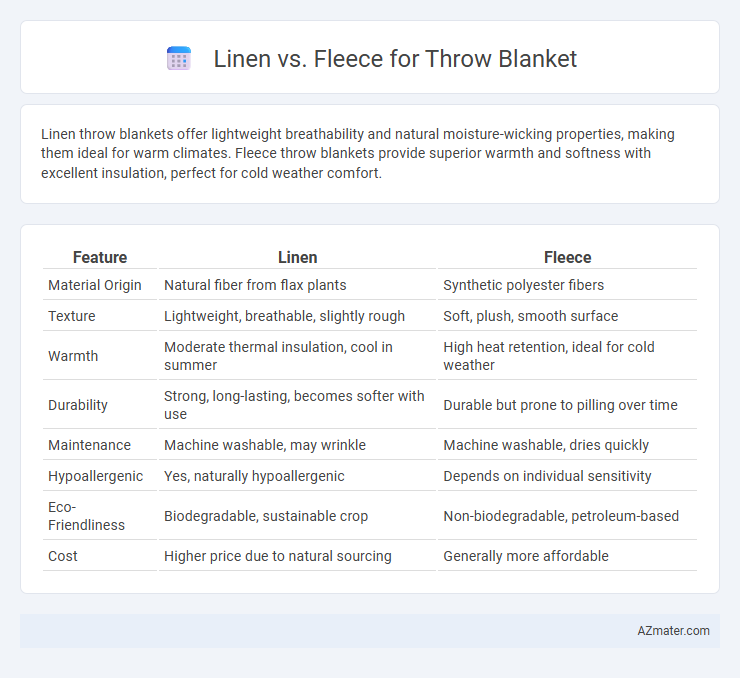Linen throw blankets offer lightweight breathability and natural moisture-wicking properties, making them ideal for warm climates. Fleece throw blankets provide superior warmth and softness with excellent insulation, perfect for cold weather comfort.
Table of Comparison
| Feature | Linen | Fleece |
|---|---|---|
| Material Origin | Natural fiber from flax plants | Synthetic polyester fibers |
| Texture | Lightweight, breathable, slightly rough | Soft, plush, smooth surface |
| Warmth | Moderate thermal insulation, cool in summer | High heat retention, ideal for cold weather |
| Durability | Strong, long-lasting, becomes softer with use | Durable but prone to pilling over time |
| Maintenance | Machine washable, may wrinkle | Machine washable, dries quickly |
| Hypoallergenic | Yes, naturally hypoallergenic | Depends on individual sensitivity |
| Eco-Friendliness | Biodegradable, sustainable crop | Non-biodegradable, petroleum-based |
| Cost | Higher price due to natural sourcing | Generally more affordable |
Introduction to Linen and Fleece Throw Blankets
Linen throw blankets are crafted from natural flax fibers, offering breathability, durability, and a lightweight feel ideal for warm climates or year-round use. Fleece throw blankets, made from synthetic polyester fibers, provide exceptional warmth, softness, and moisture-wicking properties suited for colder environments and cozy indoor settings. Both materials present distinct advantages in texture, insulation, and maintenance, catering to varying comfort and style preferences in home decor.
Material Composition: What Are Linen and Fleece?
Linen is a natural fiber made from the flax plant, known for its breathability, durability, and moisture-wicking properties, making it ideal for lightweight, cool throw blankets. Fleece is a synthetic fabric typically made from polyester, prized for its softness, warmth, and quick-drying capabilities, suitable for cozy, insulating throws. Choosing between linen and fleece depends on preferences for natural fibers versus synthetic warmth and moisture management.
Softness and Texture Comparison
Linen throw blankets offer a naturally textured surface that feels cool and breathable, making them ideal for warm weather or sensitive skin. Fleece blankets provide a plush, velvety softness with a dense pile that traps heat efficiently, perfect for cozy warmth in colder environments. The contrast in texture is significant: linen's slightly coarse weave versus fleece's smooth, fluffy finish defines the choice between breathable comfort and insulating softness.
Warmth and Insulation Qualities
Linen throw blankets offer excellent breathability and moisture-wicking properties, making them ideal for mild temperatures but less effective in retaining heat compared to fleece. Fleece blankets provide superior warmth and insulation due to their dense synthetic fibers that trap body heat, making them perfect for cold environments. Choosing fleece ensures optimal thermal retention, while linen excels in lightweight comfort and ventilation.
Breathability and Moisture Control
Linen throw blankets excel in breathability due to their natural fiber structure, allowing air to circulate freely and preventing overheating, making them ideal for warmer climates. Fleece blankets, constructed from synthetic fibers, offer less breathability but provide superior moisture-wicking capabilities, drawing sweat away from the skin to keep users dry. Choosing between linen and fleece depends on the need for ventilation versus moisture control, with linen favored for cooling comfort and fleece preferred for warmth retention and moisture management.
Durability and Longevity
Linen throw blankets exhibit exceptional durability due to their natural fiber strength and resistance to wear, making them ideal for long-term use. Fleece throw blankets offer softness and warmth but may pill and degrade faster with frequent washing and heavy use. Choosing linen ensures a longer-lasting blanket that maintains its texture and integrity over years.
Maintenance and Care Requirements
Linen throw blankets require gentle washing with mild detergent, preferably air-dried to maintain their natural fibers and prevent shrinkage, and they tend to become softer with each wash. Fleece throw blankets are machine-washable, quick-drying, and can withstand frequent laundering without losing softness, but they are prone to pilling and may require occasional fabric shaver use. Proper maintenance of linen demands careful handling to avoid wrinkles and damage, while fleece offers low-maintenance convenience ideal for easy, everyday care.
Style and Aesthetic Appeal
Linen throw blankets offer a timeless, natural aesthetic with a textured, breathable fabric that enhances minimalist and rustic decor styles. Fleece throw blankets provide a plush, cozy appearance with vibrant colors and a soft, smooth finish ideal for modern, casual, or cozy home settings. Choosing between linen and fleece depends on desired style impact--linen for understated elegance and durability, fleece for warmth and a casual, inviting look.
Eco-Friendliness and Sustainability
Linen throw blankets are highly eco-friendly due to flax plants requiring minimal water, pesticides, and synthetic fertilizers, making linen a sustainable textile choice. In contrast, fleece is typically made from polyester, a petroleum-based fabric that contributes to microplastic pollution and has a larger carbon footprint. Choosing linen supports biodegradability and reduced environmental impact, while fleece offers durability but less sustainability.
Which Throw Blanket Is Right for You?
Linen throw blankets offer breathability, moisture-wicking properties, and a lightweight feel, making them ideal for warmer climates or year-round use. Fleece blankets provide superior warmth, softness, and durability, perfect for cold weather and cozy indoor settings. Choosing between linen and fleece depends on your climate, desired comfort level, and maintenance preferences.

Infographic: Linen vs Fleece for Throw Blanket
 azmater.com
azmater.com